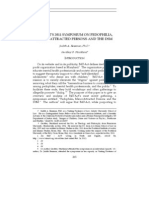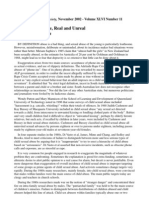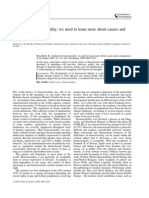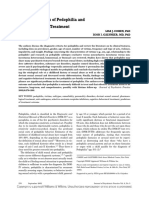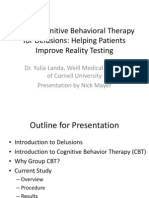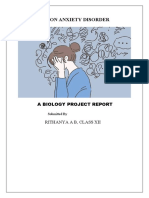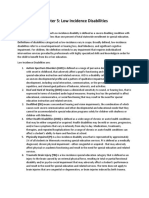Pedophilia, Minor-Attracted Persons, and The DSM
Pedophilia, Minor-Attracted Persons, and The DSM
Uploaded by
CayoBuayCopyright:
Available Formats
Pedophilia, Minor-Attracted Persons, and The DSM
Pedophilia, Minor-Attracted Persons, and The DSM
Uploaded by
CayoBuayOriginal Title
Copyright
Available Formats
Share this document
Did you find this document useful?
Is this content inappropriate?
Copyright:
Available Formats
Pedophilia, Minor-Attracted Persons, and The DSM
Pedophilia, Minor-Attracted Persons, and The DSM
Uploaded by
CayoBuayCopyright:
Available Formats
Brief Descriptions of Presentations at:
Pedophilia, Minor-Attracted Persons, and the DSM: Issues and Controversies
B4U-ACT Symposium Baltimore, MD, August 17, 2011
Fred S. Berlin, M.D., Ph.D. Understanding Pedophilia and Other Paraphilias from a Psychiatric Perspective John Z. Sadler, M.D. Decriminalizing Mental Disorder Concepts Pedophilia as an Example Lisa J. Cohen, Ph.D. and Igor I. Galynker, M.D., Ph.D. Identifying the Psychobiological Correlates of Pedophilic Desire and Behavior: How Can We Generalize Our Knowledge Beyond Forensic Samples? Renee Sorrentino, M.D. The Forensic Implications of the DSM-Vs Pedohebephilia Nancy Nyquist Potter, Ph.D. Is Anybody Out There?: Testimony of Minor-Attracted Persons and Hearing versus Listening to their Voices Richard Kramer, Ph.D. The DSM and Stigma Andrew Hinderliter, M.A. Can the Medicalization of Sexual Deviance ever be Therapeutic? Jacob Breslow, B.A. Sexual Alignment: Critiquing Sexual Orientation, The Pedophile, and the DSM V
Brief descriptions of presentation at: Pedophilia, Minor-Attracted Persons, and the DSM: Issues and Controversies B4U-ACT Symposium, Baltimore, MD, August 17, 2011
Understanding Pedophilia and Other Paraphilias from a Psychiatric Perspective
Fred S. Berlin, M.D., Ph.D. Professor of Psychiatry and Behavioral Sciences, Johns Hopkins University School of Medicine, Baltimore, MD The word Pedophilia is a diagnostic term employed by the psychiatric community to designate a specific type of mental disorder. However, today that term has taken on a different meaning in societys collective consciousness; serving as a demonizing pejorative that ostracizes those manifesting the condition. This conceptual review is intended to bring enhanced clarity to the matter of how one should understand Pedophilia from a psychiatric perspective, its cultural context, and its treatment. The presentation will also give an overview of other paraphilias as well. The review addresses (1) the nature of Pedophilia, differentiating it from disorders of character, (2) etiological contributory factors, (3) whether those with it are deserving of treatment, (4) why treatment is even needed, (5) psychosocial and medical interventions, (6) treatment outcome, and (7) recent legislative initiatives related to the condition. From a mental health perspective, it is important to appreciate that Pedophilia is meant to designate a diagnosable, and potentially treatable, psychiatric condition, rather than a criminal mind-set; a mind-set reflective of a disregard for societys values.
Brief descriptions of presentation at: Pedophilia, Minor-Attracted Persons, and the DSM: Issues and Controversies B4U-ACT Symposium, Baltimore, MD, August 17, 2011
Decriminalizing Mental Disorder Concepts Pedophilia as an Example
John Z. Sadler, M.D. Professor of Medical Ethics and Psychiatry, UT Southwestern Medical Center, Dallas, TX Vice is the term I have used in prior work as a technical term to refer to morally wrongful and/or criminal conduct. In prior work, I have argued that particular categories in DSM-IV-TR and draft DSM-5 categories and criteria are vice-laden, which means that wrongful/criminal conduct is intrinsic to the meaning of some diagnostic criteria. In my view, vice-laden diagnostic categories are problematic for several reasons: they cast psychiatry/mental health care into police-like social roles, wrongful conduct as diagnostic criterion institutionalizes and perpetuates stigma for all mental disorders, and vice-laden disorders confound public policy about the respective roles of mental health, religious and educational institutions, and criminal justice institutions in the regulation of individual conduct. Of the subgroup of DSM categories that are vice-laden, the paraphilias, especially those that involve transgression behavior with others, are deeply vice-laden as currently described in DSM categories. I present a nosological procedure that, if implemented, would minimize vice-laden diagnostic criteria and the consequent vice/mental disorder confounds in research, practice, and policy. The procedure is based upon key distinctions in moral philosophy, which separate two kinds of values: moral values, whose meanings involve concepts of good/evil and right/wrong. The other kind of value relevant here, nonmoral values, include a range of meanings relevant to illness and disorder concepts: incapacity, pain, suffering, impairment, to name a few examples. Most cases of disorder criteria are easily identified as involving moral or non-moral values. Disease and injury in physical medicine (myocardial infarctions, pneumonia, fractured femurs) universally involve nonmoral values in their defining concepts. Most mental disorder concepts in the DSM are based upon nonmoral values as well. However, some categories, including trangressive paraphilias, involve moral values in their diagnostic criteria. My basic prescription for the DSMs is that all DSM disorders should be PRIMARILY based upon nonmoral negative values: pain, suffering, disability, impairments, and incapacities of various kinds, consistent with the rest of medicine. Categories such as Pedophilia are problematic because the diagnostic criteria describe little in the way of nonmoral negative values; once trangressive molestation of minors (in fantasy or action) is removed from Pedophilia diagnostic criteria, there is almost nothing left of the disorder phenomenology in the current diagnostic criteria. Such impoverishment of the Pedophilia phenomenology raises at least two questions: (1) Should Pedophilia be considered a mental disorder at all, if it is based primarily upon fantasied or actual criminal conduct? (2) If Pedophilia and related categories are to be preserved as legitimate, nonmorally value-laden disorders, then they require a preponderance of nonmorally-value-laden diagnostic descriptors in their diagnostic criteria. I will illustrate these concepts with concrete examples from DSMIV-TR and current DSM-5 proposals, and describe in more detail how vice-laden disorders may be rehabilitated within a scientific psychiatric nosology. References Sadler, J.Z. 2008. Vice and the diagnostic classification of mental disorders: A philosophical case conference. Philosophy, Psychiatry & Psychology 15(1):1-17 Sadler, J.Z. 2005. Values and Psychiatric Diagnosis. Oxford, UK: Oxford University Press.
Brief descriptions of presentation at: Pedophilia, Minor-Attracted Persons, and the DSM: Issues and Controversies B4U-ACT Symposium, Baltimore, MD, August 17, 2011
Identifying the Psychobiological Correlates of Pedophilic Desire and Behavior: How Can We Generalize Our Knowledge Beyond Forensic Samples?
Lisa J. Cohen, Ph.D. and Igor I. Galynker, M.D., Ph.D. Director of Research for Psychology and Psychiatry, Professor of Clinical Psychiatry and Professor of Psychiatry and Behavioral Sciences Beth Israel Medical Center, Albert Einstein College of Medicine, New York, NY Objective: At present the DSM definition of pedophilia is highly rudimentary, consistent with significant limitations in our scientific knowledge about sexual attraction to prepubescent children. A solid understanding of the psychobiology of pedophilia is critical to inform treatment, prevention and public policy. Likewise, development of effective diagnostic systems, as in DSM V, is dependent on comprehensive research. However, the vast majority of research on pedophilia has relied on samples from forensic populations. This results in a skewed understanding of the phenomena of pedophilia and pedophilic desire, such that the specific correlates of pedophilic feelings are conflated with the traits of individuals who commit illegal acts. The purpose of this talk is twofold: 1) to present data from a research program studying the psychological correlates of pedophilia and 2) to consider future research directions in order to separate the factors contributing to the existence of pedophilic desire from the factors contributing to the acting on such desires. Elucidation of such factors should support the development of more precise and clinically meaningful diagnostic systems. Background: Pedophilic urges and behavior may be attributed to either aberrant motivation, inadequate inhibition or a combination of the two. The classification of pedophilia into true vs. opportunistic subgroups (also known as fixated vs. regressed or preferential vs. situational) may reflect the centrality of either motivational or inhibitory difficulties, respectively. Methods: A total of 51 subjects with pedophilia recruited from an outpatient center specializing in the treatment of sexual offenders, 53 opiate addicted individuals serving as patient controls, and 84 healthy controls were evaluated in a series of studies assessing personality traits, neuropsychological function and phallometry. Opiate addicted individuals were included as patient controls as we were interested in the concept of sexual addictions. Psychobiological and historical traits potentially associated with aberrant motivation include traits related to social anxiety and altered sexual history and function, including history of childhood sexual abuse (CSA), lowered sexual arousal threshold, and reduced erotic differentiation. Traits putatively associated with impaired inhibition include impulsivity, propensity towards cognitive distortions, and psychopathy. Results: Our findings supported increased prevalence of CSA along with elevated propensity towards cognitive distortions and psychopathy in individuals with pedophilia vs. healthy controls. Pedophiles did not differ from controls in impulsivity. Compared to opiate addicted individuals, individuals with pedophilia had higher rates of CSA, more schizoid traits, and lower impulsivity and behavioral psychopathy scores. Pedophiles did not differ from opiate addicts on social anxiety measures, but did score higher than controls. On phallometry, individuals with pedophilia showed higher erectile response overall but no evidence of reduced erotic discrimination, with clear preference for pedophilic vs. adult female stimuli. Discussion: Individuals with pedophilia drawn from an outpatient forensic sample showed elevations both in traits related to aberrant motivation and to impaired inhibition, although there was less evidence of elevated impulsivity. Heterogeneity among these traits may reflect the degree to which pedophilic urges and behavior pertain to either aberrant motivation or impaired inhibition. Future research could evaluate a non-forensic population, particularly individuals with pedophilic desires who have never acted on their desires, in order to determine what psychobiological correlates can be linked to pedophilic desire in the absence of inhibitory failure.
Brief descriptions of presentation at: Pedophilia, Minor-Attracted Persons, and the DSM: Issues and Controversies B4U-ACT Symposium, Baltimore, MD, August 17, 2011 References 1. Cohen LJ, Galynker II: Psychopathology and Personality Traits of Pedophiles: Issues for Diagnosis and Treatment. Psychiatric Times, 26(6), 25-30, 2009. 2. Cohen LJ, Nikiforov K, Watras-Gans S, Poznansky O, McGeoch P, Weaver C, Gertmenian-King E, Cullen K Galynker I. Heterosexual male perpetrators of childhood sexual abuse: A preliminary neuropsychiatric model. Psychiatric Quarterly. 73(4):313-335, 2002.
Brief descriptions of presentation at: Pedophilia, Minor-Attracted Persons, and the DSM: Issues and Controversies B4U-ACT Symposium, Baltimore, MD, August 17, 2011
The Forensic Implications of the DSM-Vs Pedohebephilia
Renee Sorrentino, M.D. Clinical Instructor in Psychiatry, Harvard Medical School, Cambridge, MA Medical Director, Institute for Sexual Wellness, Quincy, MA The influence of the American Psychiatric Association (APA) in the mental health field is clearly significant. The Diagnostic and Statistical Manual of Mental Disorders (DSM) is considered the Bible for professionals making psychiatric diagnoses. The DSM, however intended or unintended, has influenced the legal and social policy arenas by identifying and outlining behaviors and thoughts which are labeled disordered. The DSM V has proposed several diagnostic changes in the subject area of the paraphilias. For example the diagnosis of Pedophilia has been revised to Pedohebephilia. In this presentation the question of whether Pedohebephilia should be considered as a psychiatric disorder will be discussed. The theoretical foundation and scientific evidence for the inclusion of Pedohebephilia comes from abnormal and persistent sexual interests, behavioral patterns, self-reported sexual fantasy and laboratory tests. This evidence will be examined outlining the limitations and possible errors in research. The DSM V proposed revisions and science of Pedohebephilia will then be applied to the field of forensic psychiatry. The forensic implications of creating this modified paraphilic disorder will be reviewed with respect to recent sexual predator legislation, criminal responsibility, child custody evaluations, disability eligibility and dangerousness in the workplace. In conclusion, the response of forensic psychiatrists to the addition of new paraphilias, including Pedohebephilia will be presented. Two recent votes at the American Academy of Psychiatry and the Law conference (October 2010) outline important professional considerations related to the inclusion of Pedohebephilia in the DSM. References Blanchard R. "The DSM Diagnostic Criteria for Pedophilia," Archives of Sexual Behavior (April 2010): Vol. 39, No. 2, pp. 30416. Hall RC. "A Profile of Pedophilia: Definition, Characteristics of Offenders, Recidivism, Treatment Outcomes, and Forensic Issues," Mayo Clinic Proceedings (April 2007): Vol. 82, No. 4, pp. 45771. Frances A, First, Michael: Hebephilia Is Not a Mental Disorder in DSM-IV-TR and Should Not Become One in DSM-5. J Am Acad Psychiatry Law 39:78-85, 2011. Zander TK: Adult sexual attraction to early-stage adolescents: phallometry doesnt equal pathology. Arch Sex Behav 38:329-30, 2009.
Brief descriptions of presentation at: Pedophilia, Minor-Attracted Persons, and the DSM: Issues and Controversies B4U-ACT Symposium, Baltimore, MD, August 17, 2011
Is Anybody Out There?: Testimony of Minor-Attracted Persons and Hearing versus Listening to their Voices
Nancy Nyquist Potter, Ph.D. Professor of Philosophy, University of Louisville, Louisville, KY / President, Association for the Advancement of Philosophy and Psychiatry Genuine listening is a virtue, and one that is necessary if the voices of those attracted to minors are going to participate in the construction of the new DSM. Such participation is required in order to ensure that we have good science and ethical grounding that can go forward for diagnosis and treatment, while minimizing stigma and damage toward minor-attracted persons. To this end I make a distinction between hearing and listening and argue that those creating DSM-V need to cultivate a virtue in order for genuine listening to occur. This paper has three parts. First, I will argue that: 1) Hearing but not listening amounts to doing an injustice to minor-attracted persons. 2) Listener injustice (what I will refer to as testimonial injustice) is a result of prejudice, assumptions, and biases against the social identity of the speaker. 3) Testimonial injustice impedes scientific theory and practice that harms all involved in concern for and about minor-attracted persons. 4) Prejudice against speakers can be corrected by cultivating a virtuea virtue I call giving uptake. In the second section, I will set out the idea of uptake as a kind of genuine listening and explain why it is a corrective to testimonial injustice. Consider a familiar sort of exchange: How did the council meeting go? Were they receptive to your ideas? No, it was like talking to a wall. I didnt get any uptake at all. This common linguistic use of uptake disguises the depth and complexity of uptake as a virtueyet most people have a grasp of its intuitive sense. I unpack the philosophical idea of uptake as it applies to minor-attracted persons and explain how giving uptake will strengthen the construction of the DSM-5 as well as result in more ethical treatment of minor-attracted persons. Of course, speakers have to have certain virtues toonamely, that of accuracy and sincerity, and in the third part I discuss the responsibility of speakers to be trustworthy to their audiences. This paper is designed to open up the space for the appropriate giving of uptake, most immediately at the conference itself.
Brief descriptions of presentation at: Pedophilia, Minor-Attracted Persons, and the DSM: Issues and Controversies B4U-ACT Symposium, Baltimore, MD, August 17, 2011
The DSM and Stigma
Richard Kramer, Ph.D. Director of Operations, B4U-ACT, Inc., Westminster, MD This talk will present an analysis of ways in which the DSM has contributed to the stigmatization of people who are attracted to minors (MAPs), discouraging them from seeking mental health services when they are needed. This will proceed in four parts. First, I will note the important role the DSM has in professional discourse about MAPs. Even though many MAPs may not meet the diagnostic criteria for pedo(hebe)philia (as given in either DSM-IV-TR or the proposed DSM 5), the only description of attraction to minors found in the dominant professional literature is that devoted to pedophilia. That literature frequently repeats the information found in the DSM (e.g., no author, 2010). Therefore, the DSM provides the sole official definition of minor-attraction endorsed by, and disseminated to, the mental health professions. Second, I will examine those features of the DSM entry for pedo(hebe)philia that stigmatize MAPs. These include specific claims, found in the DSM-IV-TR's accompanying text (APA, 2000), about the behavior and motives of people with pedophilia. These claims are based on forensic samples and include inferences about motives. They suffer from the absence of any description of MAPs who do not violate the law, scientific support for claims regarding motives, and recognition that MAPs may have a variety of motives similar to those who are attracted to adults. As a result, the text provides a distorted and needlessly stigmatizing portrait of MAPs. The overarching problem with the DSM is its predominant focus on legal violation, thus defining MAPs solely as criminals. While the DSM 5 diagnostic criteria do not require illegal behavior, in practice such criteria have been interpreted as illegal behavior, and the literature review used to justify the proposed revisions (Blanchard, 2010) suggests that this is the intent. The review focuses on illegal behavior, and a new legal criterion has been added: use of child pornography. There is little or no discussion of non-criminological aspects of or behaviors related to pedo(hebe)philia. Third, I will present results from surveys of MAPs that demonstrate the process of stigmatization due to the DSM. These results show that large numbers of MAPs believe that MAPs could benefit from mental health services but are afraid to seek them. Their fears include those of being perceived as criminals or potential criminals whose feelings must be reported to others in their social sphere, and fears that professionals will make incorrect assumptions about their behavior and motives suggested by the DSM. These results will also show the extent to which MAPs perceive the DSM and related literature to focus on social control rather than therapeutic goals, further alienating MAPs from the mental health professions. Fourth, I will suggest ways in which MAPs, researchers, and clinicians can work together to transform the DSM into a document that more completely and accurately portrays MAPs and focuses on mental health goals. This includes involving MAPs in the revision process, basing research on non-forensic samples, and involving non-forensic researchers from a wide variety of disciplines and perspectives--advice the APA itself advocates, but the paraphilias subworkgroup has yet to heed. Unless the DSM radically changes its focus, MAPs are unlikely to voluntarily seek mental health services from clinicians who take the DSM seriously. References American Psychiatric Association (APA). (2000). Diagnostic and Statistical Manual of Mental Disorders DSM-IVTR Fourth Edition. Washington, DC: Author.
Brief descriptions of presentation at: Pedophilia, Minor-Attracted Persons, and the DSM: Issues and Controversies B4U-ACT Symposium, Baltimore, MD, August 17, 2011 Blanchard, R. (2010). The DSM diagnostic criteria for pedophilia. Archives of Sexual Behavior. Sept. 16 [Epub ahead of print]. DOI 10.1007/s10508-009-9536-0 No author. (2010). Pessimism about pedophilia. Harvard Mental Health Letter. July, 2010. Retrieved May 22, 2011 from https://www.health.harvard.edu/newsletters/Harvard_Mental_Health_Letter/2010/July/pessimism-aboutpedophilia
Brief descriptions of presentation at: Pedophilia, Minor-Attracted Persons, and the DSM: Issues and Controversies B4U-ACT Symposium, Baltimore, MD, August 17, 2011
Can the Medicalization of Sexual Deviance ever be Therapeutic?
Andrew Hinderliter, M.A. Graduate Student in Linguistics, University of Illinois at Urbana-Champaign, Champaign, IL Making compassionate mental health care available for MAPs and promoting and disseminating accurate information about them are important goals. In this presentation, I argue that the diagnosis of Pedophilia can probably never accomplish these pragmatic goals, and thus build on my previous work (Hinderliter, 2010) arguing for the declassification of the paraphilias. First, the DSMs clinical significance criteria for pedophila says that a pedophilic orientation is a disorder only if the person acts on it or is distressed because of it. Using this as the basis for research on pedophilia (or hebephilia) systematically excludes well-adjusted, law-abiding individuals, thereby promoting research that reinforces negative stereotypes. The alternative is recruiting from MAP organizations (i.e. websites), and would require gaining members trust, a serious challenge for mental health professionals, given that theyalong with journalistsare seen as the two main groups in promoting negative stereotypes about MAPs (B4U-ACT, 2011). An illuminating example from fall 2010 will be discussed, which suggests that individuals on these sites would likely be extremely hostile to anyone trying to research them from a psychopathological perspective. Second, as a branch of medicine, psychiatry should be fundamentally committed to the well-being of patients, and not a branch of the criminal justice system masquerading as medicine. To be a disorder, something must involve something negatively valued (harm). When the relevant harm is primarily toward the individual, the focus of treatment is their well-being; when it is harm to others (real or imagined), the well-being of the individual is too easily sacrificed in the name of protecting society. In DSM-III-R, the paraphilias were mental disorders if the individual was distressed about their sexual interest or had acted on it, with this second part being inconsistent with the DSMs claim that sexual deviance is not a mental disorder (Gert, 1992). If it is only a disorder if it causes distress, then the diagnosis is, in practice, restricted to individuals wanting clinical help. Or acted on it enables diagnosis in the context of sex-offender treatment and SVP commitment regardless of whether the individuals wants it or not, making it medical coercion permitted in a context where the individual is mentally capable of giving/withholding informed consent (if necessary information is given). In DSM-IV, the paraphilias were made consistent with the DSMs definition of mental disorder (Gert & Culver, 2009), by making them disorders only when they causes distress or disability, although this was an accident (First & Halon, 2008). Many people/groups opposed to the declassification of homosexuality used this change in DSM-IV to raise panic, and the APA caved to political pressure changing the account of (some) paraphilias in DSM-IV-TR. This reaction was not caused by concern for the well-being of MAPs but to promote a narrative that the declassification of homosexuality inevitably leads to acceptance of child-molesting, showing that one of the primary reasons that pedophilia is now a mental disorder is that it inspires feelings of repulsion and disgust, a basis fundamentally inconsistent with the role of physicians as healers. References B4U-ACT (2011). The B4U-ACT Survey. www.b4uact.org/science/survey/01.htm First, M. B., & Halon, R. L. (2008). Use of DSM paraphilia diagnoses in sexually violent predator commitment cases. Journal of the American Academy of Psychiatric Law, 36, 443-454. Gert, B. (1992). A sex inconsistency in DSM-III-R: The definition of mental disorder and the definition of paraphilias. Journal of Medicine and Philosophy, 17, 155171.
Brief descriptions of presentation at: Pedophilia, Minor-Attracted Persons, and the DSM: Issues and Controversies B4U-ACT Symposium, Baltimore, MD, August 17, 2011 Gert, B. & Culver, C M. (2009). Sex, Immorality, and Mental Disorders. Journal of Medicine and Philosophy, 34, 487-495 Hinderliter, A. C. (2010). Defining paraphilia: Excluding exclusion. Open Access Journal of Forensic Psychology, 2, 241-272.
Brief descriptions of presentation at: Pedophilia, Minor-Attracted Persons, and the DSM: Issues and Controversies B4U-ACT Symposium, Baltimore, MD, August 17, 2011
Sexual Alignment: Critiquing Sexual Orientation, The Pedophile, and the DSM V
Jacob Breslow, B.A. Graduate Student in Gender Research, London School of Economics and Political Science, London, UK The Diagnostic and Statistic Manual of Mental Disorders is currently under its sixth revision, and the current proposed changes put forth major revisions on how pedophilia is defined, diagnosed and understood. This paper approaches these revisions from within the critiques made by queer youth activism as well as feminist and anti-racist scholarship, framing the upcoming changes to the DSM with apprehensive praise and critical ambivalence. Within it I shall challenge normative assumptions about sexuality, personal and political identity, and childhood, both within the DSM and within wider society. One of the major changes attempts to establish a clear distinction between pedophilia as a non-diagnosable ascertainment, and pedophilic disorder as a diagnosable, distressing and non-normative disorder that requires psychiatric intervention. Allowing for a form of non-diagnosable minor attraction is exciting, as it potentially creates a sexual or political identity by which activists, scholars and clinicians can begin to better understand Minor Attracted Persons. This understanding may displace the stigma, fear and abjection that is naturalized as being attached to Minor Attracted Persons and may alter the terms by which non-normative sexualities are known. Furthermore, this paper argues that this distinction is potentially another step towards the complete re-thinking of paraphilias within the DSM a step that follows historically and theoretically from the removal of homosexuality. However, when approached with the queer and feminist lenses of mis-recognition and unintelligibility, the positive prospects of this division become quite muddled, exposing their entrenchment in problematic discourses of sexual ontology and deviance. Far from arguing for a total embrace of the upcoming changes, this paper works through the DSMs struggle to understand the pedophile through an investigation of the highly questionable and deeply assumptive clinical, empirical and theoretical studies it cites (Blanchard, 2009). These studies, some of which are the basis for the upcoming revisions, ignore or disregard their own limitations, and yet continue to make claims to truth and objectivity through problematic frameworks. Many tend to begin with the linkage of pedophilic desire to harmful and abusive relationships and acts, and end up proliferating, rather than questioning, normative gendered and sexual intelligibility. Finally, this paper frames the upcoming changes through a theory of sexual alignment critiquing the DSM for theoretically and empirically forcing connections between the blurry lines that connect (and separate) acts, desires, fantasies, and understandings of the self (Ahmed, 2006). The primary lens of critique for this paper is an in depth textual, discursive and theoretical critique of the DSM and its surrounding body of knowledge on children and pedophilia, focused on exposing the ways in which sexual acts and identities gain meaning and become known. References Blanchard, Ray. 2009. The DSM Diagnostic Criteria for Pedophilia. in Archives of Sexual Behavior, 39. American Psychiatric Association. Ahmed, Sara. 2006. Orientations: Toward a Queer Pehenomenology in GLQ 12:4. Duke University Press: Durham, NC.
You might also like
- Boys On Their Contacts With MenDocument92 pagesBoys On Their Contacts With MenKris Dave Austero75% (4)
- The Journal of Paedophilia: Pa Idik ADocument67 pagesThe Journal of Paedophilia: Pa Idik AdanielgaidNo ratings yet
- Adult Child SexDocument5 pagesAdult Child Sexoieboif67% (3)
- The Glands of The Anal Canal in Man - 1961 - John A. Eglitis and Irma EglitisDocument15 pagesThe Glands of The Anal Canal in Man - 1961 - John A. Eglitis and Irma EglitisthetoasterabidesNo ratings yet
- Arousal Confusion SyndromeDocument3 pagesArousal Confusion SyndromeJudith Reisman, Ph.D.100% (3)
- 1979 007 Men and Boys PDFDocument2 pages1979 007 Men and Boys PDFjustsomeguy2u0% (2)
- OJJDP Management Ordered Not To Distribute Reisman ReportDocument1 pageOJJDP Management Ordered Not To Distribute Reisman ReportJudith Reisman, Ph.D.No ratings yet
- Hoiw Unusual Are The Content of Paraphilias - JosephDocument9 pagesHoiw Unusual Are The Content of Paraphilias - Josepha100% (1)
- Child Pornography - An Internet CrimeDocument247 pagesChild Pornography - An Internet CrimeHanashaumy Avialda100% (1)
- Frits Bernard - Paedophilia: A Factual ReportDocument99 pagesFrits Bernard - Paedophilia: A Factual ReportRaymondGracia100% (1)
- Rev. Jesse Jackson's Abortion Flip Flop TimelineDocument9 pagesRev. Jesse Jackson's Abortion Flip Flop TimelineCarole Novielli100% (1)
- Psychiatric NursingDocument292 pagesPsychiatric Nursingkanval100% (1)
- Adolescents and Pornography A Review of 20 Years of ResearchDocument24 pagesAdolescents and Pornography A Review of 20 Years of ResearchLuiz Santos100% (1)
- Pedophilia Is Not ADocument27 pagesPedophilia Is Not APrem Morhan100% (1)
- Chapter 10 Offences Relating To Sex, PedophileDocument12 pagesChapter 10 Offences Relating To Sex, PedophileKripa Kafley100% (1)
- Child Pornography: First Report of The Dutch National RapporteurDocument344 pagesChild Pornography: First Report of The Dutch National RapporteurMarsh Law Firm PLLC50% (2)
- B4u-Act's 2011 Symposium On Pedophilia, Minor-Attracted Persons and The DSMDocument47 pagesB4u-Act's 2011 Symposium On Pedophilia, Minor-Attracted Persons and The DSMJudith Reisman, Ph.D.100% (1)
- SIECUS Sexologists Views On PedophiliaDocument2 pagesSIECUS Sexologists Views On PedophiliaAnonymous Ef2KYILq100% (2)
- PedophiliaDocument12 pagesPedophiliaShafeek Revolutionarist Homage-Com Chandrasekharan0% (1)
- Topic: Pedophilia Is Not IncreasingDocument3 pagesTopic: Pedophilia Is Not IncreasingÁi Thi DươngNo ratings yet
- PedofiliaDocument25 pagesPedofiliaSilvina Peruglia100% (1)
- Child ProstitutionDocument4 pagesChild Prostitutionmafereyes09100% (1)
- 6+ +sexualityDocument113 pages6+ +sexualityalieraongaco100% (1)
- Child Pornography and Sexual Exploitation of Children Online: A contribution of ECPATInternational to the World Congress III against Sexual Exploitation of Children and Adolescents, Rio de Janeiro, Brazil, 25-28 November 2008Document128 pagesChild Pornography and Sexual Exploitation of Children Online: A contribution of ECPATInternational to the World Congress III against Sexual Exploitation of Children and Adolescents, Rio de Janeiro, Brazil, 25-28 November 2008Marsh Law Firm PLLC100% (2)
- Dr. Teresa Nentwig Gottingen vs. Prof - DR PDFDocument28 pagesDr. Teresa Nentwig Gottingen vs. Prof - DR PDFTiago CruzNo ratings yet
- 4Document4 pages4api-242831588100% (1)
- Baldwin Steve - Child Molestation and The Homosexual MovementDocument16 pagesBaldwin Steve - Child Molestation and The Homosexual Movementgustavo conci100% (2)
- Child Sexual Abuse, Real and Unreal PDFDocument6 pagesChild Sexual Abuse, Real and Unreal PDFjustsomeguy2uNo ratings yet
- Adolescent Homosexuality Causes&ConsequencesDocument5 pagesAdolescent Homosexuality Causes&Consequences雲開No ratings yet
- Pedophile Relationships in The Netherlands: Alternative Lifestyle For Children?Document20 pagesPedophile Relationships in The Netherlands: Alternative Lifestyle For Children?PovedaNo ratings yet
- Twenty-Two of The Most Common Myths About HomosexualityDocument5 pagesTwenty-Two of The Most Common Myths About HomosexualityWherethestreets HavenonameNo ratings yet
- Frits Bernard - Pedophilia Unbound: Theory, Research, PracticeDocument154 pagesFrits Bernard - Pedophilia Unbound: Theory, Research, PracticeRaymondGracia100% (3)
- The Formation of The Homosexual IdentityDocument31 pagesThe Formation of The Homosexual IdentityMalcolm RobinsonNo ratings yet
- Perpetrators Sexually: Characteristics Child Sexual Victimized Children Craissati, 1,2Document15 pagesPerpetrators Sexually: Characteristics Child Sexual Victimized Children Craissati, 1,2Eu DenyNo ratings yet
- US Vs KnoxDocument32 pagesUS Vs KnoxJudith Reisman, Ph.D.No ratings yet
- Corporate Paedophilia Hypersexualisation of Children in The MediaDocument13 pagesCorporate Paedophilia Hypersexualisation of Children in The MediaSanchia SahaNo ratings yet
- How Children Are Conditioned by Hardcore PornographyDocument4 pagesHow Children Are Conditioned by Hardcore PornographyLobuscherNo ratings yet
- The Boys Full AlbumDocument24 pagesThe Boys Full AlbumsweetkissessNo ratings yet
- Yaoi & FandomDocument29 pagesYaoi & FandomMisty Freedom JonesNo ratings yet
- "Gender Uncertainty" Invades Public Schools As The Next Wave of The Pansexual Transformation of SocietyDocument49 pages"Gender Uncertainty" Invades Public Schools As The Next Wave of The Pansexual Transformation of SocietyJudith Reisman100% (2)
- Child Molestation Article - LitDocument4 pagesChild Molestation Article - LitLoren MandaNo ratings yet
- Research Child PornographyDocument10 pagesResearch Child Pornographyiuubi100% (1)
- The Anatomy, Histology and Development of The Penis PDFDocument9 pagesThe Anatomy, Histology and Development of The Penis PDFredderdatNo ratings yet
- Sexual Behavior of Men Who Have Sex With MenDocument32 pagesSexual Behavior of Men Who Have Sex With MenThomas OfemNo ratings yet
- Niños Porno TallerDocument34 pagesNiños Porno TallerRoger Inzunza100% (1)
- Self-Pornographic Representations With Grindr PHILLIPSDocument15 pagesSelf-Pornographic Representations With Grindr PHILLIPSRodrigo Alcocer100% (1)
- Pharmacology of Sexually Compulsive BehaviorDocument9 pagesPharmacology of Sexually Compulsive Behaviorsara_vonNo ratings yet
- SSRI For Sex OffendersDocument72 pagesSSRI For Sex OffendersnanaNo ratings yet
- Pedophilia JAMA 2002 Review TherapyDocument8 pagesPedophilia JAMA 2002 Review TherapyW Andrés S MedinaNo ratings yet
- Child Prosti 2Document71 pagesChild Prosti 2Moses100% (1)
- Timothy DefoggiDocument10 pagesTimothy DefogginicholasdeleoncircaNo ratings yet
- Obscenity Exemptions For Educational Purposes Invalidates State Harmful-to-Minors StatutesDocument69 pagesObscenity Exemptions For Educational Purposes Invalidates State Harmful-to-Minors StatutesJudith Reisman, Ph.D.100% (4)
- The Missing Children in Public Discourse On Child Sexual AbuseDocument8 pagesThe Missing Children in Public Discourse On Child Sexual AbuseJane Gilgun100% (1)
- When Victoria Becomes Albert: The Harmful Social Effects of Transgender Legislation: Application of the Principle, #5From EverandWhen Victoria Becomes Albert: The Harmful Social Effects of Transgender Legislation: Application of the Principle, #5Rating: 1 out of 5 stars1/5 (1)
- Cohen 2002Document14 pagesCohen 2002Victoria PeopleNo ratings yet
- A Discussion of Homosexuality - The Ethical Challenge - Irving Bieber 1976Document4 pagesA Discussion of Homosexuality - The Ethical Challenge - Irving Bieber 1976G s SerraNo ratings yet
- Rent Boys - DissertationDocument42 pagesRent Boys - DissertationLeniaNo ratings yet
- Study Reveals Porn Magazines Promote Sexual Abuse of ChildrenDocument3 pagesStudy Reveals Porn Magazines Promote Sexual Abuse of ChildrenJudith Reisman, Ph.D.67% (3)
- Adolescent Sexuaiity: Judith Marks Mishne D.S.WDocument2 pagesAdolescent Sexuaiity: Judith Marks Mishne D.S.WRAHMANo ratings yet
- The Betrayal of BAMDocument2 pagesThe Betrayal of BAMCayoBuayNo ratings yet
- Constitution of Belize - Constitutional ChronologyDocument3 pagesConstitution of Belize - Constitutional ChronologyCayoBuayNo ratings yet
- Economic and Financial Update - Belize - 2007Document24 pagesEconomic and Financial Update - Belize - 2007CayoBuayNo ratings yet
- Belize Intoxicating Liquor Licensing ActDocument54 pagesBelize Intoxicating Liquor Licensing ActCayoBuayNo ratings yet
- Belize Passport ApplicationDocument2 pagesBelize Passport ApplicationCayoBuayNo ratings yet
- Background and Study of The Special Agreement Between Guatemala and Belize - ICJDocument145 pagesBackground and Study of The Special Agreement Between Guatemala and Belize - ICJCayoBuayNo ratings yet
- Capacity, Commitment, and ComplianceDocument28 pagesCapacity, Commitment, and ComplianceCayoBuayNo ratings yet
- Is The International Court of Justice Biased?Document43 pagesIs The International Court of Justice Biased?CayoBuayNo ratings yet
- English Literature - 9° READING: "The Effects of Stress" INSTRUCTION: Read The Essay and Answer The Correct Answers in Your NotebookDocument3 pagesEnglish Literature - 9° READING: "The Effects of Stress" INSTRUCTION: Read The Essay and Answer The Correct Answers in Your NotebookYesicaAlejandraPalacioNo ratings yet
- Vanderbilt ADHD Report - 2337522Document12 pagesVanderbilt ADHD Report - 2337522fiza.akbar01No ratings yet
- Understanding The Suicidal MindDocument246 pagesUnderstanding The Suicidal MindLaura AndreiNo ratings yet
- G. Berrios - Analysis of 100 Cases of CotardDocument4 pagesG. Berrios - Analysis of 100 Cases of CotardHans Castorp0% (1)
- Comorbidity Between Dyslexia and Attention DeficitDocument10 pagesComorbidity Between Dyslexia and Attention DeficitAnthony NetzelNo ratings yet
- Report On SchizophreniaDocument26 pagesReport On SchizophrenianisslimsNo ratings yet
- Six Ways To Beat Childhood Trauma and Stop Self-SabotageDocument4 pagesSix Ways To Beat Childhood Trauma and Stop Self-SabotageEspíritu CiudadanoNo ratings yet
- Phobia TypesDocument16 pagesPhobia TypesMsika AloyceNo ratings yet
- Mood Disorders Lecture 1Document6 pagesMood Disorders Lecture 1DEEPIKA PREMLAL 2170101No ratings yet
- CBT Handout HannahDocument2 pagesCBT Handout Hannahapi-273614596100% (1)
- Pans TestDocument4 pagesPans Testturabk622No ratings yet
- Adoloscents Depression ScriptDocument4 pagesAdoloscents Depression Scriptnaufal rasyiqiNo ratings yet
- 001 and 002Document8 pages001 and 002Meron BerihunNo ratings yet
- Effectiveness of Coping Strategies in Reducing Student's Academic StressDocument5 pagesEffectiveness of Coping Strategies in Reducing Student's Academic StressFathur RNo ratings yet
- LD in Children For UM PDFDocument87 pagesLD in Children For UM PDFKalyhani NagaNo ratings yet
- ArachnophobiaDocument4 pagesArachnophobiahina BuutNo ratings yet
- G CBT For DelusionDocument23 pagesG CBT For DelusionIoana DarjanNo ratings yet
- Skala GafDocument1 pageSkala GafRamya HarlistyaNo ratings yet
- PB Bsc. Second Year PsychiatryDocument7 pagesPB Bsc. Second Year Psychiatryshubham verma100% (1)
- Study On Anxiety DisorderDocument18 pagesStudy On Anxiety DisorderRRRNo ratings yet
- Mental Health Case StudyDocument10 pagesMental Health Case Studyapi-401649778No ratings yet
- Thesis For PTSD Research PaperDocument8 pagesThesis For PTSD Research Papertammykordeliskinorman100% (2)
- Guide To Assessment Scales in SchizophreniaDocument92 pagesGuide To Assessment Scales in Schizophreniaحسين منصور100% (1)
- Chapter 5: Low Incidence DisabilitiesDocument2 pagesChapter 5: Low Incidence DisabilitiesIqra MunirNo ratings yet
- Clinical Manual of Emergency Psychiatry-160-205Document46 pagesClinical Manual of Emergency Psychiatry-160-205Fahrunnisa NurdinNo ratings yet
- Hypnosis and Mindfulness For The Treatment of Anxiety DisordersDocument64 pagesHypnosis and Mindfulness For The Treatment of Anxiety DisordersKableNo ratings yet
- Chapter 6 - AbpsychDocument9 pagesChapter 6 - AbpsychehhlluhhNo ratings yet
- The Genetic Basis of Major Depressive Disorder: Molecular PsychiatryDocument12 pagesThe Genetic Basis of Major Depressive Disorder: Molecular PsychiatryLilla Laura KisNo ratings yet
- Educating Students With AutismDocument12 pagesEducating Students With AutismamandasykesNo ratings yet
















